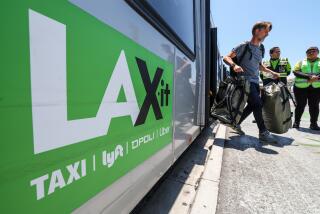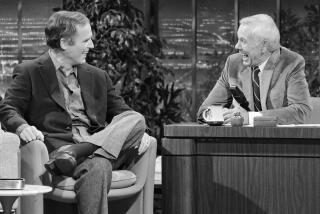At Burbank Airport : Terminal Affords VIPs a Discreet Gateway to World
In a publicity stunt staged more than a year ago, hundreds of Barry Manilow fans crowded into the Burbank airport in response to radio announcements that the pop singer was departing from there for a concert tour.
But few actually saw the singer. They were in the wrong place.
As fans searched the main commercial terminal building and pressed their noses to windows, Manilow was boarding a plane far across the field at the Martin Aviation Executive Terminal, which serves private aircraft using the airport.
Although the executive terminal is unknown to most airline passengers, some of the best-known people in the world pass through its doors, in part because the Burbank field is the closest airport to downtown Los Angeles and movie and recording studios.
Hope, Eastwood, Reynolds, Etc.
Workers at the terminal said entertainer Bob Hope is often seen there. So are actors Clint East-wood, Burt Reynolds and John Travolta. An airliner chartered by Manilow, who performed in Los Angeles on his latest tour, is tied down at Martin. Former presidential and vice presidential candidates Walter Mondale, Gary Hart and Geraldine Ferraro have landed there. So have rock star Paul McCartney and the Duke of Edinburgh.
During the Academy Awards and Emmy Awards, limousines line up in front of the terminal at 3000 N. Clybourn Ave., waiting for stars to arrive in their private jets from around the world, said Anthony Colletti, terminal general manager.
Workers at the private terminal are so protective of travelers that Colletti declines to even name those who use it. However, he acknowledges that visitors “can sit out in the lobby and probably see somebody they know” on almost any day.
“Nobody bothers them (celebrities) here,” Colletti said. “We give the same VIP service to everyone. Sometimes we get a little excited ourselves when somebody really famous comes through. But we try to be sensitive to the needs of our customers, whether they are a big star, a corporation president or just a typical traveler.”
But Colletti also acknowledges that most travelers using the terminal are far from “typical.” Most are corporate executives, members of the “Jet Set” who frequently hop across the nation and the world. Large corporations, like Standard Oil and Sears Roebuck, keep corporate jets hangared at the terminal.
Wanda Kainz, property manager for Martin Aviation, said the private terminal provides hangars and parking spaces for more than 400 private aircraft. She said owners pay from $80 a month for a tie-down space for a small, single-engine plane, to $25,000 a month for a large, multiplane hangar. She said most celebrities keep their planes in security hangars, since overly zealous fans once stole the tires from a plane owned by an entertainer who kept it outside.
Dennis Brothers, terminal operations manager, said the number of daily flights of private planes ranges from 15 to 50. Although the terminal keeps no record of the number of planes it services, Kainz said business has surged dramatically the last few months. She attributes the surge to a turnaround in the economy.
Tax Advantages Cited
Colletti disagreed. “If you can afford to own an executive jet, you’re not affected by the economy,” he said. Instead, he attributes the increase to liberalized tax advantages and depreciation allowed owners of aircraft. However, the U.S Treasury and Congress are studying proposals to eliminate some of the benefits.
The Federal Aviation Administration said private aircraft flights at Burbank steadily declined, from 236,680 in 1978 to 122,143 in 1983. The number rose to 135,287 in 1983, the latest figure available.
Other businesses at Burbank service private aircraft, but Martin Aviation has the only full-service private terminal building, which it leases from the Burbank-Glendale-Pasadena Airport Authority. The company, which took over operation of the terminal from financially troubled TigerAir last April, employs 60 workers.
Services range from repairs, maintenance, flight preparation and sales of aircraft to serving refreshments on board.
Flight Preparations
Pilots or corporate secretaries generally alert the terminal of the services needed when a plane is scheduled to depart or land. When a flight is scheduled out of Burbank, terminal workers can wash and fuel the plane, place refreshments ordered on board and tow the aircraft to a staging area, ready for boarding.
Private planes landing at Burbank are met at the runway by a van with the sign “Follow Me” on the back, and led to the private terminal. A red carpet is placed at the foot of the door and passengers and pilots are greeted and offered assistance.
The 20-year-old terminal building features a blue-carpeted passenger lounge with free refreshments and a phone center for transportation and hotel reservations. An observation deck on the roof of the terminal offers a commanding view of airport activity.
Pilots are provided with a separate lounge where they can telephone for weather information or watch television during stopovers. Shuttle vans are used to transport travelers, pilots and flight attendants to hotels and restaurants or to and from the main terminal.
The executive terminal is a frequent gathering spot for off-duty pilots and private plane owners. During one recent afternoon, several pilots had gathered at a large octagonal table in the terminal lobby, which looks out on the staging area and runway.
Charles R. Janisse, a director of a Texas aircraft corporation, propped his reptile-skin cowboy boots on the table while he discussed the design of his new turbo-prop aircraft with other pilots. Janisse, a veteran pilot, called the Burbank terminal “one of the finest base terminals around. It is exactly what every executive pilot needs.”
Michael Finnegan, an aviation sales and management consultant, had gone to the terminal to discuss the sale of a client’s $150,000 DC-3 airliner with a pilot who plans to fly Alaskan tours. Finnegan said he operated a charter service for entertainers--including Tom Jones, the Eagles and Frank Zappa--before starting his consulting service.
Finnegan said it is not unusual for entertainers to charter a passenger plane, which can cost $3,000 a day. He said some celebrities allot up to $5,000 a day for food and refreshments, a sum that he says “challenges flight attendants to invent ways to spend money.”
More to Read
Sign up for Essential California
The most important California stories and recommendations in your inbox every morning.
You may occasionally receive promotional content from the Los Angeles Times.









